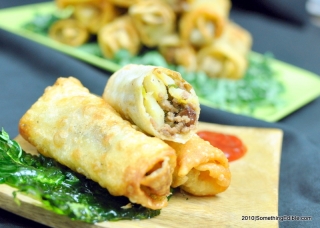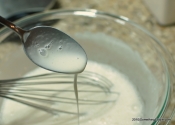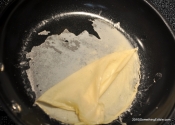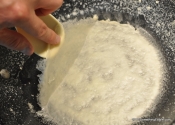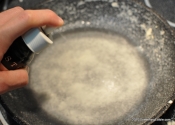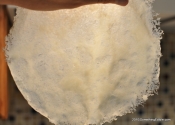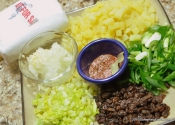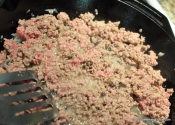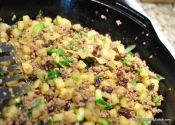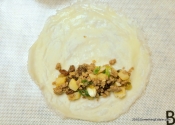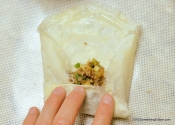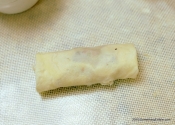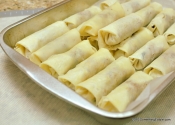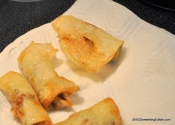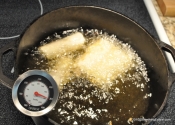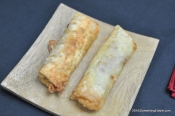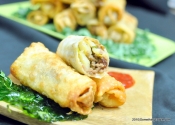Some food, some drink.
Overcoming cultural adversity by way of fried food.
Abstract: Asian cuisine is a bit hit-and-miss for me. The preparations are exciting and the ingredients can be relatively exotic. Because my white-boy self wasn't raised with any real exposure to legitimate Asian food, I'm a bit out of my element with the way things should taste; and consequently, even when I think I'm doing it right, I'll likely be screwing it up. In an effort to better myself and my cooking, I've fearlessly/naively taken on the task of cooking up a batch of Lumpia (those are Filipino spring rolls) from a good friend's family recipe - completely from scratch.
Purpose: This post and
subsequent recipe is part of the Foodbuzz
Project Food Blog event, with the second challenge being
to cook a classic dish from outside one's cultural comfort zone. It
doesn't get much more outside of my comfort zone than cooking Asian
food. The defining moment of my inexperience came about eight or
nine years ago when I first set foot in a proper Asian Market. With
so many cool and unique ingredients, I was sure I could put together
something great. Long story short: that wasn't the way it went down,
and I've been gun-shy ever since.
In an effort to get over my reluctance
to cook Asian, I began looking for perspective. My good friend Eric
happens to be Filipino, and his wife is Japanese. Both of them are
awesome
people and are some of the most
creative folk I know. With artistry and ingenuity practically
oozing from that household, I was pretty certain my friend would
have an answer for me. Eric loves food as much as I do, and with
good reason; his mother is notorious for making sure that anyone
that comes to visit leaves the house satiated.
I call Eric up, tell him my story, and
without a need to pause for thought, I'm told that I should make
Lumpia. Without even a proper description of the dish, I could tell
by the inflection in his voice that not only was this going to be
tasty, but that the recipe carried with it fond memories of family
as well. I needed to make
this dish; but more importantly, I needed to not screw it up. My
excitement was tempered as Eric mentioned to me that Lumpia have
their own special kind of wrapper. I'll spare you the expletives
that fired off in my head as I considered how far I would
have to drive to get to a proper Asian Market. Surely someone had
been in the same spot and had shared their knowledge. The only thing
left to do was to get a little bit of research done, and do some
justice to a family recipe I'd never even come close to preparing
before.
Recipe: Jump to the detailed recipe. (or, keep reading for the gist of it) -
Wrappers
Filling
For the Wrappers -
Whisk all the ingredients until very smooth.
Heat your best nonstick pan on low (~250F). Spritz pan with cooking spray, wipe it out with a paper towel and spray or paint/dab on thin layers of batter until it becomes a continuous sheet. After about 2 - 4 minutes the edges will start to pull away from the pan. Pull wrapper from the pan slowly with the help of a spatula. Spray and wipe down the pan with cooking spray before making each wrapper.
Stack wrappers pan-side down on a tea towel and store air-tight in the fridge until ready to use.
For the Filling -
Cover potato dice with water in a small pot. Salt water and add a clove of garlic. Bring to boil over medium-high heat and continue boiling until potatoes are par-cooked (roughly another 6 minutes). Rinse with cold water to stop the cooking.
In a cast-iron skillet over medium-high heat, brown hamburger with salt, pepper, bay leaf, onion and garlic until 2/3 done (you want some pink). Drain excess grease (if any) and add sugar, paprika, raisins, celery and potato. Simmer uncovered on medium heat for 7-10 minutes, stirring occasionally. Kill the heat, stir in green onion, let cool to room temperature and drain any excess liquid before attempting a wrap. If you need a break, you can also refrigerate the filling at this point and just nuke the cold filling for a minute or so to take the chill off when ready to use.
Wrapping and Cooking -
To wrap, place a scant quarter cup of the filling an inch from the bottom of each wrapper, leaving about an an inch of space at both ends. Fold the bottom over the filling, tuck in both ends, and roll neatly. Keep the roll tight as you assemble (but don't get crazy; you'll tear the wrap). Moisten the other side of the wrapper with water to seal the edge. Lay seam-side down in a covered parchment-lined pan and freeze overnight (this helps keep 'em closed).
When ready to deep-fry, heat up your cooking oil to 375F, and place the frozen lumpia in the oil seam-side down and fry until golden brown (about 3ish minutes). You'll want to keep the oil above 350F so work in small batches (for me, that's four at a time). Place on a wire rack over a sheet pan in a warm oven until ready to consume.
Observation:
- First a bit of history –
I'm told that these aren't exactly the Lumpia you're going to find if you're
traveling in the Philippines. This is a recipe that crossed the
ocean with the family, and has taken on some of the tastes of
western culture.
- Eric tells me that his Mom's lumpia filling actually has a lot in common with another Filipino staple, guisantes or “pork and peas”. However, beef is king in Kansas and has been substituted accordingly.
- Eric's Great-Grandmother is responsible for the addition of raisins, which back then made it something special; as in the Philippines, raisins are an import.
- If you're not blessed with a local Asian market, You'll have to make your own wrappers. The lumpia wrappers I made are a derivation of this recipe (god-bless the Interwebs; I would have been lost). The method in the recipe says to paint a very runny batter into a warm pan. The brush method was passable, but I wasn't real thrilled with the lack of an even thickness. To ensure a better level of precision, I opted to spray-paint.
- Do not try to treat this batter like a crepe by pouring it into the pan. Your results will be too thick, and won't fry up crisp. If you're going to half-ass it, you might was well buy egg roll wraps.
- On to the filling: Do not overcook the potatoes. Eric's Mom's notes were very specific about this. Par-cook in the boiling water, and let them finish while simmering with the rest of the filling ingredients. I'd also recommend a lower-starch potato such as a red or Yukon gold over a Russet.
- If your beef is lean enough, I wouldn't bother draining any excess fat or liquid until after it's done cooking. Otherwise, you're just throwing away flavor before it's had time to develop.
- Don't neglect your knife-work for the veggies, as the way your filling ingredients are handled affects the overall textural outcome. Ditto for the beef; make sure it gets good and crumbly.
- When rolling up your lumpia, you'll want the roll tight, but don't over-do it or you'll tear that wrapper you worked so hard to make.
- I'm going to say that the overnight freeze is an absolute necessity if you want to ensure that your roll remains sealed and your filling doesn't get overcooked.
- It's also important to note that because the pre-fried rolls freeze so well, you can make-ahead a whole mess of lumpia (and a whole mess of your kitchen) and have homemade convenience food at-the-ready.
- When frying, shoot for a temperature of 375F, knowing that it will plummet to 350F once the food is added. Don't crowd the fryer, and always place your lumpia in the fryer seam-side down. Keep the finished rolls on a rack atop a sheet pan in a warm oven.
Results: I'm not going to pretend like I know
what Lumpia should taste
like, and any constructive criticism you can bestow on this ignorant
Caucasian is certainly welcome. For my results, I ended up with a
crispy and delicate wrapper that held a satisfying bite of meat and
potatoes. Unlike so many other spring rolls where the truth of the
contents is often left to imagination, the combination of proper
seasoning and texture let every ingredient remain flavorful and
distinctly identifiable.
You can't really
have a spring roll without something to dip it in. When asking Eric
about his choice of condiment, he reluctantly suggested ketchup (and
blamed his “gringo-tainted tastebuds” for his
preference). I ran with that, and put the Asian back into mine by
dosing my “American table sauce” with Sriracha, which
seemed appropriate for a family recipe that's evolved and flourished
in a journey across two hemispheres.
Notes: Thank-you Eric, and Thank-you Eric's Mom, for allowing me the privilege to cook this family favorite. Yours is a dish that transcends a cultural barrier that so often makes Asian cuisine a difficult study for myself. -bd
Gallery:
This runny mess will be a light and crispy wrap after being cooked and then fried.
This runny mess will be a light and crispy wrap after being cooked and then fried.
Damn. I tried to pull this one before it was done. The wrap recipe gives you a little extra, taking into consideration operator error.
Damn. I tried to pull this one before it was done. The wrap recipe gives you a little extra, taking into consideration operator error.
My rice spatula is no longer a uni-tasker. See how the edges are pulling from the side of the pan? That's how you know your Lumpia wrapper is done.
My rice spatula is no longer a uni-tasker. See how the edges are pulling from the side of the pan? That's how you know your Lumpia wrapper is done.
I was always better with a can of spray paint than a brush. Loading my batter in an aerosol pump got me a thin, even texture.
I was always better with a can of spray paint than a brush. Loading my batter in an aerosol pump got me a thin, even texture.
Cue the trumpets! Afaik, this is as close to a proper lumpia wrapper as I'm gonna get; delicate yet flexible, and as thin as paper.
Cue the trumpets! Afaik, this is as close to a proper lumpia wrapper as I'm gonna get; delicate yet flexible, and as thin as paper.
The wrappers are complete, so it's time to focus on the lumpia filling. Everything we need has been prepped and is ready to throw in the pan.
The wrappers are complete, so it's time to focus on the lumpia filling. Everything we need has been prepped and is ready to throw in the pan.
Yeah, I know it's still raw, but if you don't add the rest of the ingredients now, the beef will be overcooked later.
Yeah, I know it's still raw, but if you don't add the rest of the ingredients now, the beef will be overcooked later.
Here is the just-completed lumpia filling. Make sure to add the green onions after you kill the heat, so they don't overcook into oblivion.
Here is the just-completed lumpia filling. Make sure to add the green onions after you kill the heat, so they don't overcook into oblivion.
How to wrap a lumpia, Step 1: Place a scant 1/4 cup of filling near the bottom of the wrap, and moisten the top edge of the wrap with water.
How to wrap a lumpia, Step 1: Place a scant 1/4 cup of filling near the bottom of the wrap, and moisten the top edge of the wrap with water.
How to wrap a lumpia, Step 2: Fold up the sides and bottom about an inch up, so as to make an envelope.
How to wrap a lumpia, Step 2: Fold up the sides and bottom about an inch up, so as to make an envelope.
How to wrap a lumpia, Step 3: Roll everything tight and place seam-side down. See where it sorta blew out at the bottom? Mine was a bit too tight.
How to wrap a lumpia, Step 3: Roll everything tight and place seam-side down. See where it sorta blew out at the bottom? Mine was a bit too tight.
The lumpia are laid seam-side down in a parchment-lined pan to be covered and frozen. If you have to do multiple layers, it's a good idea to separate each…
The lumpia are laid seam-side down in a parchment-lined pan to be covered and frozen. If you have to do multiple layers, it's a good idea to separate each with parchment.
Laying the lumpia seam-side down in the fryer will mitigate the likelihood of blowouts (they're still tasty though).
Laying the lumpia seam-side down in the fryer will mitigate the likelihood of blowouts (they're still tasty though).
One minute before I put those four lumpia in the fryer, the thermometer read 375F. Allow for that thermal plunge to keep the fry times abrupt.
One minute before I put those four lumpia in the fryer, the thermometer read 375F. Allow for that thermal plunge to keep the fry times abrupt.
I wrapped a lumpia with a supermarket-grade egg roll wrapper to show y'all a side-by-side difference in texture. Seeing is believing. Not thin, not crisp.…
I wrapped a lumpia with a supermarket-grade egg roll wrapper to show y'all a side-by-side difference in texture. Seeing is believing. Not thin, not crisp. Meh.
Get Social
Please wait while my tweets load...
Get the latest recipes and news. Join our Facebook page!



